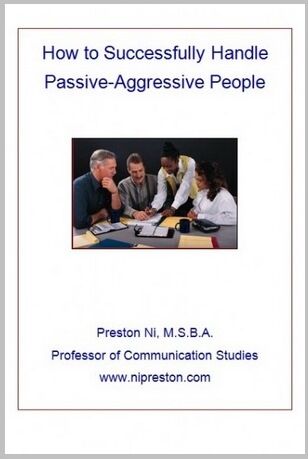Passive-Aggression
6 Tips for Dealing With Passive-Aggressive People
There are ways to get along without sacrificing your emotional wellness.
Posted January 11, 2015 Reviewed by Kaja Perina

Are you dealing with someone who’s passive-aggressive in your personal life? Perhaps this individual is a romantic interest, a family member, or a social contact. Relating to a passive-aggressive person can be a difficult experience, with many moments of frustration, anger, and despair. How can you get a good handle on the situation and maintain your equanimity? Below are keys to successfully handle passive-aggressive personal relationships, with references from my books (click on titles): “How to Successfully Handle Passive-Aggressive People” and “A Practical Guide for Passive-Aggressives to Change Towards the Higher Self”. Not all of these ideas may apply to your particular situation, simply use what works and leave the rest.
1. Notice Passive-Aggressive Behavior Early
It’s easy to overlook or dismiss signs of passive-aggression in a relatively new relationship, such as a dating prospect or social contact. After all, most of us like to give people the benefit of the doubt, and prefer not to have our guard up right away. When a relatively new passive-aggressive acquaintance makes a sarcastic remark, breaks a personal promise, puts-up excuses for not following through, gives the silent treatment, or claims victimhood, we may feel inclined to excuse the behavior as the exception rather than the norm, and hope that it will not happen again.
While you may be correct in giving this person another chance, if the sign(s) of possible passive-aggressiveness honestly bothers you, it’s also time to start paying closer attention, to check if the behavior is an isolated incident, or part of an unhealthy pattern. Notice whether the person instigates additional passive-aggressive behavior towards you. In addition, observe whether he or she shows passive-aggressive tendencies towards others, especially with those whom this individual may have power struggles, such as a family member, supervisor, colleague, or past romantic partner.
Once you identify a clear pattern of passive-aggressive behavior, it’s time to determine what type of relationship you want to have with this person, if you desire to keep a relationship at all, and make proactive choices with your relational health and well-being as priorities.
2. Get to Know the Passive-Aggressive’s History
If possible and appropriate, get to know the passive-aggressive to understand their behavior. It’s not your job to change the passive-aggressive, or to be their counselor or therapist. The purpose of the exercise below is simply for your own awareness and education. Understanding a passive-aggressive’s history may provide valuable insights linking past suffering to present demeanor.
In casual and friendly conversations, ask open-ended, none-judgmental questions about the passive-aggressive’s background, to ascertain whether there may be hidden (repressed) sources of hostility, anger, and/or resentment. Passive-aggressive behavior often arises when an individual feels powerless and lacks a strong voice in a challenging environment. If the negative life experience is salient enough to be psychologically anchored, one’s passive-aggressive instinct may emerge repeatedly in other, approximating dynamics (such as a husband who unconsciously deals with his mother issues through his wife). The passive-aggressive, out of the fear of being dominated once more, may utilize a set of survival and resistance strategies to avoid (in his or her perception) being victimized again.
Certain passive-aggressive types may exhibit their negative behavior more at home, while others more at work. Some may show their repressed anger towards everyone, while others may selectively direct their covert hostility towards the opposite sex, or competitive peers, or authority figures, etc. Since the root causes of pathological passive-aggressiveness are complex and deep-seated, you may never get a full picture of why the passive-aggressive behaves as he does. But even a partial understanding can be helpful.
3. Avoid Being the Passive Aggressive’s Trigger
In romantic (and often non-romantic) relationships, many passive-aggressives subconsciously choose a partner with whom he or she can re-enact power struggles of the past, based on psychological familiarly (pathology), and perhaps an unconscious desire to “win over” past wrongs. This means that if you’re the passive-aggressive’s partner, it’s important to avoid behaving and communicating in ways that may trigger the passive-aggressive’s worst instincts.
Crucially, ask yourself: “Am I unknowingly giving into, encouraging, or eliciting my partner’s passive-aggressive behavior?”
For instance, are you playing one or more of the following roles in your relationship with your partner:
A. The Passive Sufferer: Indulging your partner’s passive-aggression without communicating assertively or setting firm boundaries.
Possible trigger in the passive-aggressive partner: Encouraging more of the same, undesirable conduct. Normalizing unacceptable demeanor. Reinforcing the belief that he can take advantage of and “get away” with subversive behavior.
B. The Baby Sitter/Rescuer: You’ve become your partner’s caretaker, constantly cleaning up after the partner’s misdeeds, undoing his or her damage, or rescuing your partner from victimhood and “crisis”.
Possible trigger in the passive-aggressive partner: Indulging more of the same, undesirable conduct. Why should your partner change if you’re always there to cover for him? The passive-aggressive may secretly enjoy being waited on, which gives him a sense of power. The relationship becomes an unhealthy one of parent taking care of child, or child taking care of parent.
C. The Coach and Judge: You’ve become your partner’s critic, regularly telling him or her to change for the better, berating him for not taking responsibility, or setting performance expectations to which you know he’s likely not to respond.
Possible trigger in the passive-aggressive partner: You may be unwittingly inviting your partner to re-engage in his or her battles of the past, when he had to resist either a strong individual or domineering environment in order to survive. This has become a power struggle.
4. In Relatively Mild Situations, Display Superior Composure Through Appropriate Humor.
Humor is a powerful communication tool. Years ago I knew a co-worker who was quite stuck-up. One day a colleague of mine said, “Hello, how are you?” to him. When the egotistical co-worker ignored her greeting completely, my colleague didn’t feel offended. Instead, she smiled good-naturedly and quipped, “That good, huh?” This broke the ice and the two of them started a friendly conversation. Brilliant.
When appropriately used, humor can shine light on the truth, disarm difficult behavior, and show that you have superior composure.
5. Give the Passive-Aggressive a Chance to Help Solve the Problem, If Appropriate
Many passive-aggressive individuals behave as they do because they don’t believe they have a voice, or think that they’re not being listened to. When appropriate, include the person in discussions on challenges and solutions. Solicit their input. Ask, for example, "Given the desired outcome, how would you handle this issue?" See if they come up with any constructive solutions. On the other hand, if what you hear are mostly complaints and criticisms, don’t agree or disagree. Simply say that you’ll keep what they said in mind, and get on with what you need to get done.
6. Set Consequences to Lower Resistance and Compel Cooperation
Since passive-aggressive individuals operate covertly, they will almost always put up resistance when confronted on their behavior. Denial, excuse making, and finger pointing are just a few of the likely retorts. Regardless of what they say, declare what you're willing to do going forward. Importantly, offer one or more strong consequences to compel the passive-aggressive to reconsider his or her behavior.
The ability to identify and assert consequence is one of the most powerful skills we can use to "stand down" a passive-aggressive person. Effectively articulated, consequence gives pause to the difficult individual, and compels her or him to shift from obstruction to cooperation. In my book “How to Successfully Handle Passive-Aggressive People”, consequence is presented as seven different types of power you can utilize to affect positive change.
Although passive-aggressive relationships are not pleasant to deal with, there are many effective skills and strategies you can employ to minimize their damage and gain their cooperation, while increasing your own confidence, composure, and problem-solving prowess. It’s one important aspect of leadership success.


For more tips on dealing with passive-aggressiveness, see my books (click on titles): “How to Successfully Handle Passive-Aggressive People” and “A Practical Guide for Passive-Aggressives to Change Towards the Higher Self”.
© 2015 by Preston C. Ni. All rights reserved worldwide. Copyright violation may subject the violator to legal prosecution.




